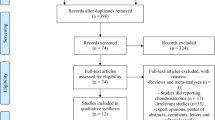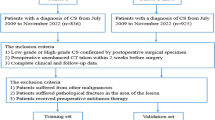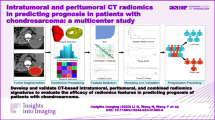Abstract
Objective
To evaluate the study quality and clinical value of radiomics studies on chondrosarcoma.
Methods
PubMed, Embase, Web of Science, China National Knowledge Infrastructure, and Wanfang Data were searched for articles on radiomics for evaluating chondrosarcoma as of January 31, 2022. The study quality was assessed according to Radiomics Quality Score (RQS), Transparent Reporting of a multivariable prediction model for Individual Prognosis Or Diagnosis (TRIPOD) checklist, Image Biomarker Standardization Initiative (IBSI) guideline, and modified Quality Assessment of Diagnostic Accuracy Studies (QUADAS-2) tool. The level of evidence supporting clinical use of radiomics on chondrosarcoma differential diagnosis was determined based on meta-analyses.
Results
Twelve articles were included. The median RQS was 10.5 (range, −3 to 15), with an adherence rate of 36%. The adherence rate was extremely low in domains of high-level evidence (0%), open science and data (17%), and imaging and segmentation (35%). The adherence rate of the TRIPOD checklist was 61%, and low for section of title and abstract (13%), introduction (42%), and results (56%). The reporting rate of pre-processing steps according to the IBSI guideline was 60%. The risk of bias and concern of application were mainly related to the index test. The meta-analysis on differential diagnosis of enchondromas vs. chondrosarcomas showed a diagnostic odds ratio of 43.90 (95% confidential interval, 25.33–76.10), which was rated as weak evidence.
Conclusions
The current scientific and reporting quality of radiomics studies on chondrosarcoma was insufficient. Radiomics has potential in facilitating the optimization of operation decision-making in chondrosarcoma.
Key Points
• Among radiomics studies on chondrosarcoma, although differential diagnostic models showed promising performance, only pieces of weak level of evidence were reached with insufficient study quality.
• Since the RQS rating, the TRIPOD checklist, and the IBSI guideline have largely overlapped with each other, it is necessary to establish one widely acceptable methodological and reporting guideline for radiomics research.
• The TRIPOD model typing, the phase classification of image mining studies, and the level of evidence category are useful tools to assess the gap between academic research and clinical application, although their modifications for radiomics studies are needed.




Similar content being viewed by others
Abbreviations
- CI:
-
Confidence interval
- DOR:
-
Diagnostic odds ratio
- HSROC:
-
Hierarchical summary receiver operating characteristic
- IBSI:
-
Image Biomarker Standardization Initiative
- QUADAS-2:
-
modified Quality Assessment of Diagnostic Accuracy Studies
- RQS:
-
Radiomics Quality Score
- TRIPOD:
-
Transparent Reporting of a multivariable prediction model for Individual Prognosis Or Diagnosis
References
WHO Classification of Tumours Edition Board (2020) World Health Organization classification of tumours: WHO classification of tumours of soft tissue and bone, 5th edn. IARC Press, Lyon
Strauss SJ, Frezza AM, Abecassis N et al; ESMO Guidelines Committee, EURACAN, GENTURIS and ERN PaedCan (2021) Bone sarcomas: ESMO-EURACAN-GENTURIS-ERN PaedCan clinical practice guideline for diagnosis, treatment and follow-up. Ann Oncol 32(12): 1520-1536
National Comprehensive Cancer Network (2021) NCCN clinical practice guidelines in oncology: Bone Cancer, version 2. 2022 – October 8, 2021. Available https://www.nccn.org/professionals/physician_gls/pdf/bone.pdf. Accessed Jan 2022
Chen X, Yu LJ, Peng HM et al (2017) Is intralesional resection suitable for central grade 1 chondrosarcoma: a systematic review and updated meta-analysis. Eur J Surg Oncol 43(9):1718–1726
Stevenson JD, Laitinen MK, Parry MC, Sumathi V, Grimer RJ, Jeys LM (2018) The role of surgical margins in chondrosarcoma. Eur J Surg Oncol 44(9):1412–1418
van Praag Veroniek VM, Rueten-Budde AJ, Ho V, Dijkstra PDS, Fiocco M, van de Sander MAJ, Study group Bone and Soft tissue tumours (WeBot) (2018) Incidence, outcomes and prognostic factors during 25 years of treatment of chondrosarcomas. Surg Oncol 27(3):402–408
Logie CI, Walker EA, Forsberg JA, Potter BK, Murphey MD (2013) Chondrosarcoma: a diagnostic imager’s guide to decision making and patient management. Semin Musculoskelet Radiol 17(2):101–115
Sharif B, Lindsay D, Saifuddin A (2021) The role of imaging in differentiating low-grade and high-grade central chondral tumours. Eur J Radiol 137:109579
Crim J, Schmidt R, Layfield L, Hanrahan C, Manaster BJ (2015) Can imaging criteria distinguish enchondroma from grade 1 chondrosarcoma? Eur J Radiol 84(11):2222–2230. https://doi.org/10.1016/j.ejrad.2015.06.033
Douis H, Parry M, Vaiyapuri S, Davies AM (2019) What are the differentiating clinical and MRI-features of enchondromas from low-grade chondrosarcomas? Eur Radiol 28(1):398–409
Deckers C, Steyvers MJ, Hannink G, Schreuder HWB, de Rooy JWJ, Van Der Geest ICM (2020) Can MRI differentiate between atypical cartilaginous tumors and high-grade chondrosarcoma? A systematic review. Acta Orthop 91(4):471–478
Jo I, Gould D, Schlicht S, Taubman K, Choong P (2019) Diagnostic accuracy of functional imaging modalities for chondrosarcoma: a systematic review and meta-analysis. J Bone Oncol 19:100262
Patel A, Davies AM, Botchu R, James S (2019) A pragmatic approach to the imaging and follow-up of solitary central cartilage tumours of the proximal humerus and knee. Clin Radiol 74(7):517–526
Skeletal Lesions Interobserver Correlation among Expert Diagnosticians (SLICED) Study Group (2007) Reliability of histopathologic and radiologic grading of cartilaginous neoplasms in long bones. J Bone Joint Surg Am 89(10):2113–2123
Eefting D, Schrage YM, Geirnaerdt MJ et al; EuroBoNeT consortium (2009) Assessment of interobserver variability and histologic parameters to improve reliability in classification and grading of central cartilaginous tumors. Am J Surg Pathol 33(1): 50-57
Lambin P, Rios-Velazquez E, Leijenaar R et al (2012) Radiomics: extracting more information from medical images using advanced feature analysis. Eur J Cancer 48:441–446
Gillies RJ, Kinahan PE, Hricak H (2016) Radiomics: images are more than pictures, they are data. Radiology 278:563–577
O’Connor JP, Aboagye EO, Adams JE et al (2017) Imaging biomarker roadmap for cancer studies. Nat Rev Clin Oncol 14:169–186
Crombé A, Fadli D, Italiano A, Saut O, Buy X, Kind M (2020) Systematic review of sarcomas radiomics studies: bridging the gap between concepts and clinical applications? Eur J Radiol 132:109283
Gitto S, Cuocolo R, Albano D et al (2021) CT and MRI radiomics of bone and soft-tissue sarcomas: a systematic review of reproducibility and validation strategies. Insights Imaging 12(1):68
Zhong J, Hu Y, Si L et al (2021) A systematic review of radiomics in osteosarcoma: utilizing radiomics quality score as a tool promoting clinical translation. Eur Radiol 31(3):1526–1535
Page MJ, McKenzie JE, Bossuyt PM et al (2021) The PRISMA 2020 statement: an updated guideline for reporting systematic reviews. BMJ 372:n71
Collins GS, Reitsma JB, Altman DG, Moons KG (2015) Transparent reporting of a multivariable prediction model for individual prognosis or diagnosis (TRIPOD): the TRIPOD statement. Ann Intern Med 162(1):55–63
Zwanenburg A, Vallières M, Abdalah MA et al (2020) The image biomarker standardization initiative: standardized quantitative radiomics for high-throughput image-based phenotyping. Radiology 295(2):328–338
Whiting PF, Rutjes AW, Westwood, ME et al; QUADAS-2 Group (2011) QUADAS-2: a revised tool for the quality assessment of diagnostic accuracy studies. Ann Intern Med 155(8): 529-536
Park JE, Kim D, Kim HS et al (2020) Quality of science and reporting of radiomics in oncologic studies: room for improvement according to radiomics quality score and TRIPOD statement. Eur Radiol 30(1):523–536
Lee S, Han K, Suh YJ (2022) Quality assessment of radiomics research in cardiac CT: a systematic review. Eur Radiol. https://doi.org/10.1007/s00330-021-08429-0
Won SY, Park YW, Ahn SS et al (2021) Quality assessment of meningioma radiomics studies: bridging the gap between exploratory research and clinical applications. Eur J Radiol 138:109673
Park CJ, Park YW, Ahn SS et al (2022) Quality of radiomics research on brain metastasis: a roadmap to promote clinical translation. Korean J Radiol 23(1):77–88
Sollini M, Antunovic L, Chiti A, Kirienko M (2019) Towards clinical application of image mining: a systematic review on artificial intelligence and radiomics. Eur J Nucl Med Mol Imaging 46(13):2656–2672
Dang Y, Hou Y (2021) The prognostic value of late gadolinium enhancement in heart diseases: an umbrella review of meta-analyses of observational studies. Eur Radiol 31(7):4528–4537
Deng XY, Chen HY, Yu JN et al (2021) Diagnostic value of CT- and MRI-based texture analysis and imaging findings for grading cartilaginous tumors in long bones. Front Oncol 11:700204
Fritz B, Müller DA, Sutter R et al (2018) Magnetic resonance imaging-based grading of cartilaginous bone tumors: added value of quantitative texture analysis. Invest Radiol 53(11):663–672
Gitto S, Cuocolo R, Albano D et al (2020) MRI radiomics-based machine-learning classification of bone chondrosarcoma. Eur J Radiol 128:109043
Gitto S, Cuocolo R, Annovazzi A et al (2021) CT radiomics-based machine learning classification of atypical cartilaginous tumours and appendicular chondrosarcomas. EBioMedicine 68:103407
Gitto S, Cuocolo R, van Langevelde K et al (2022) MRI radiomics-based machine learning classification of atypical cartilaginous tumour and grade II chondrosarcoma of long bones. EBioMedicine 75:103757
Li L, Wang K, Ma X et al (2019) Radiomic analysis of multiparametric magnetic resonance imaging for differentiating skull base chordoma and chondrosarcoma. Eur J Radiol 118:81–87
Lisson CS, Lisson CG, Flosdorf K et al (2018) Diagnostic value of MRI-based 3D texture analysis for tissue characterisation and discrimination of low-grade chondrosarcoma from enchondroma: a pilot study. Eur Radiol 28(2):468–477
Pan J, Jiang Y, Zhan Y et al (2020) Radiomics models based on non-enhanced MRI can differentiate chondrosarcoma from enchondroma. J South Med Univ 40(4):483–490 [Article in Chinese]
Pan J, Zhang K, Le H (2021) Radiomics nomograms based on non-enhanced MRI and clinical risk factors for the differentiation of chondrosarcoma from enchondroma. J Magn Reson Imaging 54(4):1314–1323
Yin P, Mao N, Liu X et al (2020) Can clinical radiomics nomogram based on 3D multiparametric MRI features and clinical characteristics estimate early recurrence of pelvic chondrosarcoma? J Magn Reson Imaging 51(2):435–445
Yin P, Zhi X, Sun C et al (2021) Radiomics models for the preoperative prediction of pelvic and sacral tumor types: a single-center retrospective study of 795 cases. Front Oncol 11:709659
Zhou X, Xu L, Lin P, Ye Z (2019) Identification of enchondroma and chondrosarcoma in long bone using radiomics features extracted from magnetic resonance images. J Pract Oncol 34(3):219–226 [Article in Chinese]
Liu Z, Zhang XY, Shi YJ et al (2017) Radiomics analysis for evaluation of pathological complete response to neoadjuvant chemoradiotherapy in locally advanced rectal cancer. Clin Cancer Res 23(23):7253–7262
Pfaehler E, Zhovannik I, Wei L et al (2021) A systematic review and quality of reporting checklist for repeatability and reproducibility of radiomic features. Phys Imaging Radiat Oncol 20:69–75
Acknowledgements
The authors would like to express their gratitude to Dr. Shiqi Mao from the Department of Medical Oncology, Shanghai Pulmonary Hospital, Thoracic Cancer Institute, Tongji University School of Medicine, for his suggestions on data visualization.
Funding
This study has received funding from the National Natural Science Foundation of China (81771790), Yangfan Project of Science and Technology Commission of Shanghai Municipality (22YF1442400), Medicine and Engineering Combination Project of Shanghai Jiao Tong University (YG2019ZDB09), and Research Fund of Tongren Hospital, Shanghai Jiao Tong University School of Medicine (TRKYRC-XX202204, 2020TRYJ(LB)06, 2020TRYJ(JC)07, TRGG202101, TRYJ2021JC06).
Author information
Authors and Affiliations
Corresponding authors
Ethics declarations
Guarantor
The scientific guarantor of this publication is Prof. Weiwu Yao.
Conflict of interest
The authors of this manuscript declare no relationships with any companies, whose products or services may be related to the subject matter of the article.
Statistics and biometry
One of the authors has significant statistical expertise.
Informed consent
Written informed consent was not required for this study because of the nature of our study, which was a systematic review and meta-analysis.
Ethical approval
Institutional Review Board approval was not required because of the nature of our study, which was a systematic review and meta-analysis.
Methodology
• retrospective
• diagnostic or prognostic study
• multicenter study
Additional information
Publisher’s note
Springer Nature remains neutral with regard to jurisdictional claims in published maps and institutional affiliations.
Supplementary information
ESM 1
(PDF 1778 kb)
Rights and permissions
Springer Nature or its licensor holds exclusive rights to this article under a publishing agreement with the author(s) or other rightsholder(s); author self-archiving of the accepted manuscript version of this article is solely governed by the terms of such publishing agreement and applicable law.
About this article
Cite this article
Zhong, J., Hu, Y., Ge, X. et al. A systematic review of radiomics in chondrosarcoma: assessment of study quality and clinical value needs handy tools. Eur Radiol 33, 1433–1444 (2023). https://doi.org/10.1007/s00330-022-09060-3
Received:
Revised:
Accepted:
Published:
Issue Date:
DOI: https://doi.org/10.1007/s00330-022-09060-3




